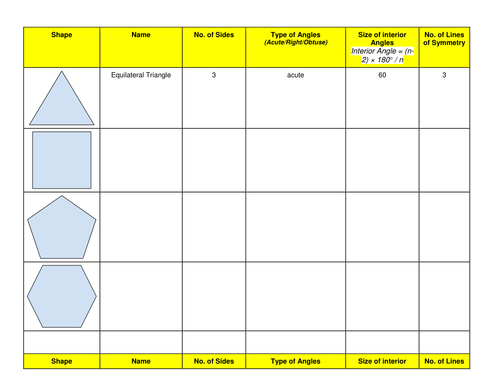
6Uploads
2k+Views
57Downloads
All resources

Spelling Log & Word Play
A resource for KS2 children to keep on top of their spelling corrections throughout the year. It has a link to various Word Play activities. I use this using Google Docs. It is shared with child and myself.

Exploring Regular Polygons
An activity to help children explore regular polygons, explaining their properties.
I recommend children use toothpicks to make each shape on the table, and then use a protractor to measure the interior angles. They should use a mirror to find the lines of symmetry.
I share children into the Google Doc format so that they can work collaboratively.

The Human Body Research Tasks (IPC unit: How Human's Work)
This resource allows children to research various topics linked to the IPC unit: How Humans Work, over a 3 week period.
There are 9 research topics and children will need to research 5 of them over the 3 weeks.
The topics are:
The Digestive System
Human and Animal Teeth
Eyes and Sight
Ears and Hearing
Skeletons and Muscles
Healthy Eating
Heart and Exercise
Human Life Cycle
Smoking and Alcohol
Week 1: The Digestive System (obligatory)
Week 2: Choose any 2 from the purple tasks
Week 3: Choose any 2 from the green tasks.
Children will have choice over the tasks they choose. You can even change the centre (obligatory) task to the one that you mostly want the children to learn about.
Each task includes key questions, ideas for how to record and present tasks, and useful child friendly links to guide children’s research.

Guidelines to plan and write a KS2 Scientific Report
A resource designed to help KS2 primary children focus on the key scientific process skills when planning and writing up scientific experiments/investigations.

Assessing Creative Writing in terms of a percentage
After many years of thinking of ways to assess creative writing, I finally came up with, and used successfully, this template.
Ever wondered why you got a creative writing assessment back with 64%, for example. Why was this not 65%, 70% etc. How did they get these random numbers?
This spreadsheet aims to eradicate this guesswork and uses a more logical approach to obtain a percentage, based on the key creative writing areas, for example, Purpose/Organisation & Structure, Vocabulary, Grammar, Punctuation, Spelling and Handwriting. Just think of each area as a number from 1 to 5 (1=low; 5 = high). Then, each of the previously areas are weighted in terms of their importance. Enter your numbers for each category and the spreadsheet will generate the percentage.
This could be adapted to link to National Curriculum criterion, and even be used for KS3.

Assessing Creative Writing in terms of a Percentage
After many years of thinking of ways to assess creative writing, I finally came up with, and used successfully, this template.
Ever wondered why you got a creative writing assessment back with 64%, for example. Why was this not 65%, 70% etc. How did they get these random numbers?
This spreadsheet aims to eradicate this guesswork and uses a more logical approach to obtain a percentage, based on the key creative writing areas, for example, Purpose/Organisation & Structure, Vocabulary, Grammar, Punctuation, Spelling and Handwriting. Just think of each area as a number from 1 to 5 (1=low; 5 = high). Then, each of the previously areas are weighted in terms of their importance. Enter your numbers for each category and the spreadsheet will generate the percentage.
This could be adapted to link to National Curriculum criterion, and even be used for KS3.






